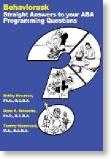Profound failure looks like this
07/10/11 15:46
Another day, another child without treatment, this time with disasterous results. A judge has just cleared a special education teacher of charges regarding her behavior in restraining a student with autism in Indiana. Now parents in Indiana are concerned that the rights of children with autism will not be protected with respect to restraints.
This conversation misses the mark. Unfortunately, there are a small number of children with autism who engage in self-injurious behavior; however, the point is not that teachers need to restrain children with autism in a particular way. The larger question is this: Why are children with autism not given treatment for their self-injurious behavior prior to being put in a classroom? That child should not be restrained in a classroom -- that’s not going to get rid of his self-injurious behavior. In fact, it may escalate it! By the time the system resorts to physical restraints, it admits to having profoundly failed.
This child needs one-on-one treatment to extinguish the self-injurious behavior completely. What kind of life is it for the pre-teen to have no way to remove that behavior from his repertoire? The fact that the child is twelve years old and is still self-injurious exemplifies the complete failure of the educational system in terms of children with autism.
If science had not progressed to the point where we know what to do, we could all throw up our hands and say, isn’t that sad; however, we know what to do and have known for some time. In 1996, Richard Foxx wrote the important article “Twenty years of applied behavior analysis in treating the most severe problem behavior: Lessons learned.” Apparently, we’ve ignored those lessons. We’re either too stingy or too short-sighted to provide that child with the treatment he needs – – at our peril.
What the school system must do, and what the parents would be wise to fight for, is to hire a highly qualified Behavior Analyst (with an expertise in self-injurious behavior) to work with the child individually to extinguish all self-injurious behavior.
This child is twelve years old. Without treatment, his world will begin to shrink, and his future will not be rosy; however, with treatment he will have the opportunity to reach his potential and, most certainly, a more fulfilling life. Don’t we owe it to him?
This conversation misses the mark. Unfortunately, there are a small number of children with autism who engage in self-injurious behavior; however, the point is not that teachers need to restrain children with autism in a particular way. The larger question is this: Why are children with autism not given treatment for their self-injurious behavior prior to being put in a classroom? That child should not be restrained in a classroom -- that’s not going to get rid of his self-injurious behavior. In fact, it may escalate it! By the time the system resorts to physical restraints, it admits to having profoundly failed.
This child needs one-on-one treatment to extinguish the self-injurious behavior completely. What kind of life is it for the pre-teen to have no way to remove that behavior from his repertoire? The fact that the child is twelve years old and is still self-injurious exemplifies the complete failure of the educational system in terms of children with autism.
If science had not progressed to the point where we know what to do, we could all throw up our hands and say, isn’t that sad; however, we know what to do and have known for some time. In 1996, Richard Foxx wrote the important article “Twenty years of applied behavior analysis in treating the most severe problem behavior: Lessons learned.” Apparently, we’ve ignored those lessons. We’re either too stingy or too short-sighted to provide that child with the treatment he needs – – at our peril.
What the school system must do, and what the parents would be wise to fight for, is to hire a highly qualified Behavior Analyst (with an expertise in self-injurious behavior) to work with the child individually to extinguish all self-injurious behavior.
This child is twelve years old. Without treatment, his world will begin to shrink, and his future will not be rosy; however, with treatment he will have the opportunity to reach his potential and, most certainly, a more fulfilling life. Don’t we owe it to him?












